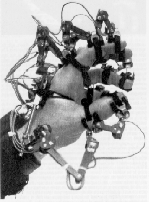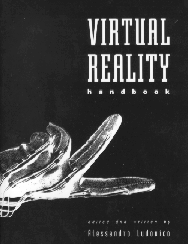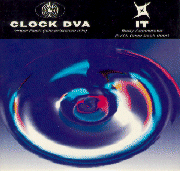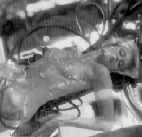


Numerous research in to applied technologies have all arrived at similar implications (Electrosex and Teledildonics) How Wachspress a hardware hacker from San Francisco, invented a device capable of converting sound into tactile sensations. Danilo De Rossi has engineered a "Smart Skin", this artificial dermis is capable of sensing pressure to varying degrees and can sense texture as fine as the bumps on a braille manuscript. Currently telephone sex has emerged. In a recent paper by Allucquere Rosanne Stone, "Sex and Death Among the Disembodied" she describes the process of constructing desire through a single mode of communication. In this process the participants draw on cultural codes to construct a scenario that compresses large amounts of information into a very small space. To many the idea of electrosex and teledildonics seems repugnant, computer ethicist Joseph Weizenbaum would consider it anti human, and perhaps it is. Contemporary philosophers have pointed to progressive mechanisation of human culture and the future of sexual expression as a site of a potential cultural collision of immense dimensions. The secondary social effects of technosex are potentially revolutionary. If technology enables you to experience erotic frissons or deep physical, social, emotional communion with another person, with no possibility of pregnancy or sexually transmitted disease, what then of conventional morality, and what of the social rituals and cultural codes that exist solely to enforce that morality? Is disembodiment the ultimate sexual revolution and/or the first step toward abandoning our bodies?
It is interesting, in fact revealing that man has long been obsessed by the idea of automata or externalized machines taking the form of a human being, and their potential to be an ideal answer that can overcome the numerous limitations we as organic structures have been unable to overcome. Over the course of my research I have come upon many references and indeed entire documents based upon these ideas. One such work I think deserves a special place due to the concepts that it proposes, published in 1886 but it is now that these ideas have become more relevant towards the future state of bio-mechanics, a pre Tyrell Corporation Blueprint for the next generation.
Jean Marie Mathias Phillipe Auguste Villiers de I'Isle Adam was an impoverished minor French aristocrat, a writer with a general taste for the bizarre and a special fascination for certain erotic and sadistic eccentricities which he portrays with vividness and spectacle. L'Eve future is set in New York, it tells of an English aristocrat. Lord Ewald, and his love for a comedian, Alicia Clary. Ewald is unhappy, however, for he finds that the mind of his beloved is focused on trivial affairs, and not on him. In a pit of despair he contemplates suicide, but he meet an inventor, 'Thomas Edison', who suggests that he may have the answer to the problem. He will construct a woman to fulfill Ewald's dreams: "Give me three weeks, and I will present a transubstantiation which... will not be a woman, but an angel, not a mistress, but a lover, more than reality, an ideal."
He therefore conceived the idea of constructing an 'ideal woman', an android (andreide is the term used in the book) which would serve the needs of men. After various prototypes he has constructed Hadaly, an android with remarkable proprieties. She is introduced to the noble Lord, entering the room like a beautiful apparition, moving, speaking. Ewald is both astounded and entranced, and in incredulous when Edison explains: "Miss Hadaly is no more than an electronic construction - metal that walks, speaks, responds, obeys, not somebody dressed up.
He then sets out to describe in great details (much of the novel consists of a dialogue between the two men) how the android was made and how the various mechanisms work. The bones are formed of ivory, with a 'galvanic marrow' that is in constant contact with a network of induction filaments linked together like a web of nerves and veins. The body temperature is accurately maintained by electrical heating and cooling of a vital fluid which also helps to control movement.
The 'electro-human creature' is constructed in four parts. The first is a life system which controls balance, gait, voice, gestures, facial expression and the innermost regulating mechanism ("or, in other words, the soul"). Then there is a metal covering which provides a flexible skeleton to which the other structures are attached. A deep skin and 'muscle' layer, permeated by animating fluid, gives the body proportion, shape and sex. Finally there is a top skin layer which determines the shading, texture lines and recognizable appearance. It is at this level that the fine lip movements, the barely perceptible details of facial expression and the subtle eye movements are controlled. Speech comes from the two golden phonographs places where the lungs would be. They plays golden discs ("better for recording female speech and resistant to oxidation") able to store up to seven hours of material. These provide a kaleidoscope of words with various colors and intonations, and house the vocal dictionary which is accessed to compose speech to fit the context of a conversation. Gestures and facial expressions are controlled by means of small revolving barrels with tiny protrusions, as in a musical box. Theses are connected to the android's 'nervous system' and represents a repertoire of seventy separate movements, including lip movements precisely synchronized with the sounds of speech.
Villers shows his familiarity with the achievements of the automata-makers, with the legend of Prometheus, and with the sciences of physiology and electromagnetics. The book reveals also the influence of innovations in doll design. Paris was at that time world famous for its dolls, many of which incorporated ingenious mechanisms to make them true miniature automata. With each new season the repertoire of the behavior broadened as the products competed for a larger share of the market. Dolls were able to swim, dance, 'breathe' and simulate various physiological functions. And in 1893, only a few years after L'Eve was written, the famous Jumeau company produced the Bebe Phonographe which spoke and sang by means of a tiny gramophone hidden in its chest. The idea for a phonograph doll, however, had first been patented in 1878 in the USA, the patent holder being none other than that prodigious inventor Thomas Edison.
The late 19th century witnessed, also many experiments concerned with projecting moving pictures, and again Edison was one of the pioneers. Such frantic activity in visual and auditory simulation renewed hopes that technological advances would provide new ways of constructing realistic automata. Villier's particular interests led him to speculate about whether this field of invention might provide new opportunities for sensual pleasure. He was no the only one to have such fantasies, for a number of more frankly pornographic adaptations of the android theme emerged over the next two decades, notable La Femme Endormie (1899) by Madame B.
Before plunging into questions about whether it is ethical to build or moral to use teledildonic technology, it pays to ask how far today's technology seems to be from achieving such capabilities, because the answers appears to be: very far. Fiber optic networks will be required to handle the very high bandwidth that tactile teleprescence requires, perhaps including the kind of hybrid circuit and packet switched technology NTT is installing in Japan as 'broadband ISDN'; fortuitously, it looks like the world is going to be webbed with fiber optic bundles for other reasons. Carrying information back and forth across town, continent, or hemisphere in large amounts, fairly quickly, will not be a problem. Until the speed of light barrier is broken, the physical size of the planet precludes a truly instantaneous on line share cyberspace; the larger your cyberspace is distributed geographically, the larger your system lag time is likely to be. The computation load generated by such a system is definitely a problem, too, a show stopper in fact, in terms of today's computing capabilities. The most serious technical obstacles that make the teledonics an early to mid twenty first century technology rather than next years fad lie in the extremely powerful computers needed top perform the enormous number of added calculations required to monitor and control hundreds and thousands of sensors and effectors. Every nook and protuberance, every plane and valley and knob of your body's surface, will require its own processor. Transducers are a real problems, as well. it will take decades to develop the mesh of tiny, high speed, safe but powerful tactile effectors: today's vibrators are in the ENIAC era. The engineering problems in building transducers, the parts of the system that communicate in a form that people can squeeze and scratch, stroke and probe, may be formidable, but they are already the subject of focused effort on three continents. Hennequin with his pneumatics and Johnson with his shape memory alloy are not the only ones. Researchers at ATR in Japan were very interested in the transmission of touch. Researchers in Italy may have just made a big step toward the kind of intimate cyber garment described above. A very crude prototype of the light weight sensor effector mesh has already been developed.
These scientific frontiers provide the jumping off point for the VR sex fantasy: put together a highly refined version of 'smart skin' with enough computing power, cleverly designed software, some kind of effector system, and a high speed telecommunication network, and you have a teledonics system. Teledonics seems to be a thought experiment that got out of control. The quantum physicists had used this technique of imagining a certain set of conditions as a kind of mental scenario, a Gedanken experiment, a 'though experiment'. The idea is to induce people to put themselves into an appropriate mindset for seeing the implications of a new discovery.
Most computers of the future will be responsive to human modes of communication including touch, gestures, speech, and eye movements. High precision exoskeletons such as the Series 2 Dextrous Hand Master already permit one to manipulate computer generated images in artificially generated reality environments, control robotic hands, and measure hand strain. Within the next few years, musicians, dancers, artists, film makers, sports enthusiasts, surgeons, and masseuses will have access to these devices. Applications of exoskeletons are limitless.
The device show here uses sensors attached to each finger joint to measure three bending and side to side motions of each finger. Twenty joint angle measurements are collected by an IBM AT, Macintosh, or VME computer at very fast rates.

References:

Xtreme Voyage
Across the void new embryos meander, a succession of wholly simulated worlds and reality's cloning which will reach in the near future levels where it is possible to induce suggestions which are now unthinkable.
The amplification of body and mind beyond planned capabilities: a technological man/machine symbiosis which is without precedents, bound to progressive prefectioning in time.
The irresistible desire to experiment this 'xtreme voyage' lays in the illusory loss of the natural limits which are linked to 'mankind'.
To reach giant of microscopic dimensions according to necessities, to immeasurably lengthen our limbs, to look through things, to camouflage ourselves with virtual environments and endless other possibilities, all these things make this new technology a social selectable weapon with unforecastable developments.
The virtual scenario could also mean, in a short time, the overcoming of rules and schemes which have constituted for centuries the fundamental bases of social living for generations.
Perhaps a dimension where instincts, even the most repressed ones, would materialize, without touching other individuals' freedom.
In this context, and not by chance, many begin to see the possibility of simulating sexual acts with virtual partners (even if at present time interfaces for this purpose do not exist), just because anyone would love to feel free to live 'experiences' with personal 'codes' without having to confront other individuals, in a space liberated from pre-concepts and unwelcome 'controls'.
Beyond (positive or negative) prospects, the large capitals gravitating around the developments of virtual worlds will very soon attract 'undesirable guests' (profiteers, politicians, etc...), ready to guide and then control, according to their interests, software programming, mostly if it is addressed to social use. if the endpoint were in any case a society oriented towards a more synthetic and speedier life than now, with the consequent disappearance of useless dead periods and stress, Virtual reality would probably be the most adequate tool to quicken the path. The possibility to interact with hundreds of new 'realities' each day could immensely increase our knowledge, creating all the assumptions for the subversion of the present life system. Body acceleration is close.